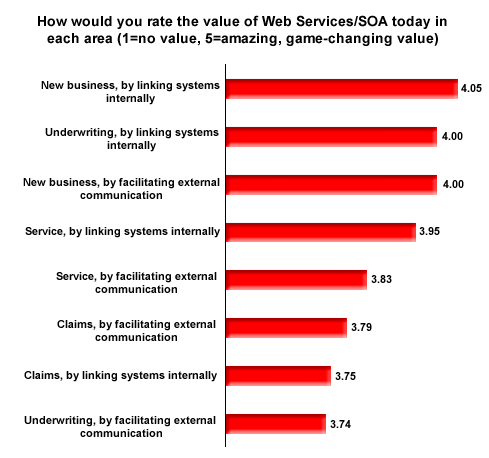Web Services and SOA in Insurance 2007: Realizing and Communicating the Business Value
Abstract
Large insurers have already realized integration efficiencies ranging from 10% to 49% from their investments in SOA.
Insurers are using Web services and service-oriented architecture (Web services/SOA) to reduce integration costs and make developing systems for new business, underwriting, and claims more efficient and effective, according to a new report from Celent that draws on survey data and interviews from more than 20 insurers.
"Web services and SOA are delivering real business value today, even in places where initiatives are limited to less than a dozen reusable services," says Matthew Josefowicz, managing director of the Insurance group at Celent and primary author of the report. "Unfortunately, today's hype, which focuses on the potentially transformational capabilities of a true process-driven architecture, is distracting attention from the short-term value of these limited deployments."
"The hype is unimportant. Web services/SOA may be a 'plumbing' issue, but it's no less important for that. Deploying even a few reusable services can have an important impact on extending insurers' already stretched IT resources," Josefowicz continues. "While purists may quibble about whether this constitutes SOA, that discussion is beside the point."

Celent's report finds that the majority of large insurers and a significant minority of midsize insurers use Web services/SOA today to create business value across the entire product/policyholder life cycle.As insurers look toward the next 18 months, they expect their Web services/SOA investments to have the greatest impact in reducing their internal integration burden.
"The reduction of systems integration burdens is a potential game-changer, in that it allows CIOs to reallocate scarce resources to more strategic application development. By their own internal measurements, many large insurers say that their investments in Web services/SOA had already yielded savings on integration costs in subsequent projects that ranged from 10% to 49%.
"Sadly, most insurers have not taken formal steps to quantify the value of their initiatives, which leads to a lack of appreciation from the business side," notes Josefowicz. "We believe that quantifying the value is a critical task for IT."
The 30-page report offers a simplified model to help IT groups get started quantifying the business value, as well as over 15 charts and tables of survey data covering a wide range of areas including:
- Current state of adoption
- Relative value of Web Services/SOA across business areas
- Most valuable individual services deployed, by business area
- Most common technology platforms used
Celent advises insurer IT groups to start small with Web services/SOA, but start today, since even a few reusable services yield real business results. Ensure that vendors support SOA-based integration, and document investments and savings carefully to demonstrate the value clearly to the business side.
A table of contents is available online.
Members of Celent's Property/Casualty Insurance and Life/Health Insurance research services can download the report electronically by clicking on the icon to the left. Non-members should contact info@celent.com for more information.

